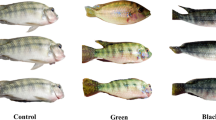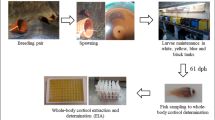Abstract
The effects of tank color on the growth, stress responses, and skin color of snakeskin gourami (Trichogaster pectoralis) were investigated in this study. Fish with initial body weights of 5.03±0.00 g were reared in five experimental tank colors (white, red, green, blue, and black) for 8 weeks. Each tank color was tested in triplicate with an initial stocking density of 15 fish per tank. Fish were fed with commercial sinking pellets at 4% of the average body weight per day. Growth performance, feed utilization efficiency, stress indicators (hematocrit, blood glucose, plasma cortisol levels), and skin color parameters were investigated. The fish reared in blue tanks had a significantly higher average final body weight (9.73 ± 0.14 g) and significantly lower average feed conversion ratio (3.42 ± 0.12) than the fish reared in black tanks (P < 0.05). The fish reared in black tanks exhibited higher average hematocrit (36.63 ± 1.11%), blood glucose (48.33 ± 1.45 mg dL−1), and plasma cortisol (9.00 ± 0.56 μg dL−1) levels than those reared in the other tank colors. However, the blood glucose levels in only the fish reared in black tanks were significantly higher than those in the fish reared in the other tank colors. The fish skin color ranged from very pale (high skin lightness) in the white tanks to very dark (low skin lightness) in the black tanks, and 80% of the variation in skin lightness were explained by the tank lightness. The use of a blue tank resulted in normal skin color; hence, blue tanks will not affect the customer acceptance of the fish. Our study revealed that blue is the most appropriate tank color for culturing snakeskin gourami.



Similar content being viewed by others
Abbreviations
- α-MSH :
-
Alpha-melanocyte-stimulating hormone
- a * :
-
Redness or greenness
- ANOVA:
-
Analysis of variance
- b * :
-
Yellowness or blueness
- C * :
-
Chroma
- CIE:
-
International Commission on Illumination
- FBW:
-
Final body weight
- FCR:
-
Feed conversion ratio
- FI:
-
Feed intake
- H°:
-
Hue angle
- IBW:
-
Initial body weight
- L * :
-
Lightness
- MCH:
-
Melanin-concentrating hormone
- SGR:
-
Specific growth rate
- SR:
-
Survival rate
- WG:
-
Weight gain
References
AOAC (2000) Official methods of analysis, 17th edn. Association of Official Analytical Chemists, Gaithersburg
Banan A, Kalbassi M, Bahmani M, Sadati M (2011) Effects of colored light and tank color on growth indices and some physiological parameters of juvenile beluga (Huso huso). J Appl Ichthyol 27(2):565–570. https://doi.org/10.1111/j.1439-0426.2011.01682.x
Barton B, Morgan J, Vijayan M (2002) Physiological condition-related indicators of environmental stress in fish. In: Adam S (ed) Biological indicators of aquatic ecosystem stress. American fisheries society, Bethesda, pp 111–148
Brännäs E, Alanärä A, Magnhagen C (2001) The social behaviour of fish. In: Keeling L, Gonyou H (eds) Social behaviour in farm animals. CABI publishing, Wallingford, pp 275–304
Burton D, Vokey J (2000) The relative in vitro responsiveness of melanophores of winter flounder to α-MSH and MCH. J Fish Biol 56:1192–1200
CIE (1976) Colorimetry. Publication No. 15. Bureau central de la CIE, Vienna
Crook A (1997) Colour patterns in a coral reef fish is background complexity important? J Exp Mar Biol Ecol 217(2):237–252. https://doi.org/10.1016/S0022-0981(97)00059-2
Ebrahimi G (2011) Effects of rearing tank background color on growth performance in juvenile common carp, Cyprinus carpio L. Agric J 6:213–217
El-Sayed A, El-Ghobashy A (2011) Effects of tank colour and feed colour on growth and feed utilization of thinlip mullet (Liza ramada) larvae. Aquac Res 42(8):1163–1169. https://doi.org/10.1111/j.1365-2109.2010.02704.x
Eslamloo K, Akhavan S, Eslamifar A, Henry M (2015) Effects of background colour on growth performance, skin pigmentation, physiological condition and innate immune responses of goldfish, Carassius auratus. Aquac Res 46(1):202–215. https://doi.org/10.1111/are.12177
Fujii R (2000) The regulation of motile activity in fish chromatophores. Pigment Cell Res 13(5):300–319. https://doi.org/10.1034/j.1600-0749.2000.130502.x
Green J, Baker B, Kawauchi H (1991) The effect of rearing rainbow trout on black or white backgrounds on their secretion of melanin-concentrating hormone and their sensitivity to stress. J Endocrinol 128:267–274
Harder T, Summerfelt R (1996) Effects of tank color and size on the success of training walleye fingerlings to formulated feed. In: Libey G, Timmons M (eds) Successes and failures in commercial recirculating aquaculture, vol 2. Northeast regional agricultural engineering service, Ithaca, pp 631–636
Höglund E, Balm P, Winberg S (2002) Behavioural and neuroendocrine effects of environmental background colour and social interaction in Arctic charr (Salvelinus alpinus). J Exp Biol 205:2535–2543
Imanpoor M, Abdollahi M (2011) Effects of tank color on growth, stress response and skin color of juvenile Caspian Kutum Rutilus frisii kutum. Glob Vet 6:118–125
Jegede T (2011) Effects of colour on growth of Oreochromis niloticus (Linnaeus 1757) fingerlings. Int J Biol Chem Sci 5:371–374
Kesbiç O, Yiğit M, Acar Ü (2016) Effects of tank color on growth performance and nitrogen excretion of European seabass (Dicentrarchus labrax) juveniles. Proc Natl Acad Sci India B 86(1):205–210. https://doi.org/10.1007/s40011-014-0441-5
McLean E, Cotter P, Thain C, King N (2008) Tank color impacts performance of cultured fish. Ribarstvo 66:43–54
Merighe G, Pereira-da-Silva E, Negrão J, Ribeiro S (2004) Effect of background color on the social stress of Nile tilapia (Oreochromis niloticus). Rev Bras Zootec 33(4):828–837. https://doi.org/10.1590/S1516-35982004000400002
Mommsen T, Vijayan M, Moon T (1999) Cortisol in teleosts: dynamics, mechanisms of action, and metabolic regulation. Rev Fish Biol Fish 9:211–268
Okomoda V, Tiamiyu L, Wase G (2017) Effects of tank background colour on growth performance and feed utilization of African catfish Clarias gariepinus (Burchell, 1822) fingerlings. Croat J Fish 75:5–11
Papoutsoglou S, Mylonakis G, Miliou H, Karakatsouli N, Chadio S (2000) Effects of background color on growth performances and physiological responses of scaled carp (Cyprinus carpio L.) reared in a closed circulated system. Aquac Eng 22:309–318
Papoutsoglou S, Karakatsouli N, Chiras G (2005) Dietary L-tryptophan and tank colour effects on growth performance of rainbow trout (Oncorhynchus mykiss) juveniles reared in a recirculating water system. Aquac Eng 32:277–284
Polovina J (1991) Fisheries applications and biological impacts of artificial habitats. In: Seaman W Jr, Sprague L (eds) Artificial habitats for marine and freshwater fisheries. Academic Press, San Diego, pp 153–176
Raghavan P, Xiao-Ming Z, Wu L, Dong H, Yun-Xia Y, Shou-Qi X (2013) Rearing tank color influences survival and growth of the early larvae of the yellow catfish, Pelteobagrus fulvidraco, Richardson. Acta Hydrobiol Sin 37:177–184
Rainboth W (1996) Fishes of the Cambodian Mekong. Food and Agriculture Organization of the United Nations, Rome
Rodríguez M, Lewis W (1997) Structure of fish assemblages along environmental gradients in floodplain lakes of the Orinoco River. Ecol Monogr 67(1):109–128.
Rotllant J, Tort L, Montero D, Pavlidis M (2003) Background colour influence on the stress response in cultured red porgy Pagrus pagrus. Aquaculture 223(1-4):129–139. https://doi.org/10.1016/S0044-8486(03)00157-1
Ruchin A (2004) Influence of colored light on growth rate of juveniles of fish. Fish Physiol Biochem 30(2):175–178. https://doi.org/10.1007/s10695-005-1263-4
Saszik S, Bilotta J (2001) Constant dark-rearing effects on visual adaptation of the zebrafish ERG. Int J Dev Neurosci 19(7):611–619. https://doi.org/10.1016/S0736-5748(01)00051-X
Stevens M (2016) Color change, phenotypic plasticity, and camouflage. Front Ecol Evol 4:1–10
Strand Å, Alanärä A, Staffan F, Magnhagen C (2007) Effects of tank colour and light intensity on feed intake, growth rate and energy expenditure of juvenile Eurasian perch, Perca fluviatilis L. Aquaculture 272(1-4):312–318. https://doi.org/10.1016/j.aquaculture.2007.08.052
Stuart-Fox D, Moussalli A (2009) Camouflage, communication and thermoregulation: lessons from colour changing organisms. Philos Trans R Soc Lond Ser B Biol Sci 364(1516):463–470. https://doi.org/10.1098/rstb.2008.0254
Sugimoto M, Yuki M, Miyakoshi T, Maruko K (2005) The influence of long-term chromatic adaptation on pigment cells and striped pigment patterns in the skin of the zebrafish, Danio rerio. J Exp Zool 303A(6):430–440. https://doi.org/10.1002/jez.a.177
Takahashi A, Mizusawa K, Amano M (2014) Multifunctional roles of melanocyte-stimulating hormone and melanin-concentrating hormone in fish: evolution from classical body color change. Aqua-BioSci Monogr 7(1):1–46. https://doi.org/10.5047/absm.2014.00701.0001
Üstündağ M, Rad F (2015) Effect of different tank colors on growth performance of rainbow trout juvenile (Oncorhynchus mykiss Walbaum, 1792). Tarim Bilimleri Dergisi 21:144–151
Vidthayanon C (2002) Peat swamp fishes of Thailand. Office of environmental policy and planning, Bangkok
Vromant N, Nam C, Ollevier F (2001) Growth performance of Trichogaster pectoralis Regan in intensively cultivated rice fields. Aquac Res 32:913–921
Wang C, Li J, Wang L, Zhao Z, Luo L, Du X (2016) Effects of tank colour on feeding, growth and stress responses of young taimen Hucho taimen (Pallas, 1773). J Appl Ichthyol 32(2):339–342. https://doi.org/10.1111/jai.12982
Wang C, Xu Q, Li J, Wang L (2017) Effects of tank colour on growth and survival of taimen Hucho taimen (Pallas, 1773) larvae. Aquac Int 25(1):437–446. https://doi.org/10.1007/s10499-016-0041-x
Wei L, Kamarudin S, Tajudin M (2013) Farming snakeskin gourami, Trichogaster pectoralis, for poverty eradication. In: proceedings of the 4th RENPER international seminar on poverty eradication, Universiti Malaysia Kelantan, Kampus Jeli, 23–25 October 2013
Yoonpundh R, Little D (1997) Trends in the farming of the snakeskin gourami (Trichogaster pectoralis) in Thailand. Naga ICLARM Q 20:18–20
Acknowledgements
This study was financially supported by the Prince of Songkla University, contract no. SIT580899S. The authors would like to thank Jamjuree Masawas, Prangthip Thongkhaw, Sirinan Nunsuwan, Sarayut Onsanit, and Seppo Karrila for their contributions to this project.
Author information
Authors and Affiliations
Corresponding author
Rights and permissions
About this article
Cite this article
Ninwichian, P., Phuwan, N., Jakpim, K. et al. Effects of tank color on the growth, stress responses, and skin color of snakeskin gourami (Trichogaster pectoralis). Aquacult Int 26, 659–672 (2018). https://doi.org/10.1007/s10499-018-0242-6
Received:
Accepted:
Published:
Issue Date:
DOI: https://doi.org/10.1007/s10499-018-0242-6




